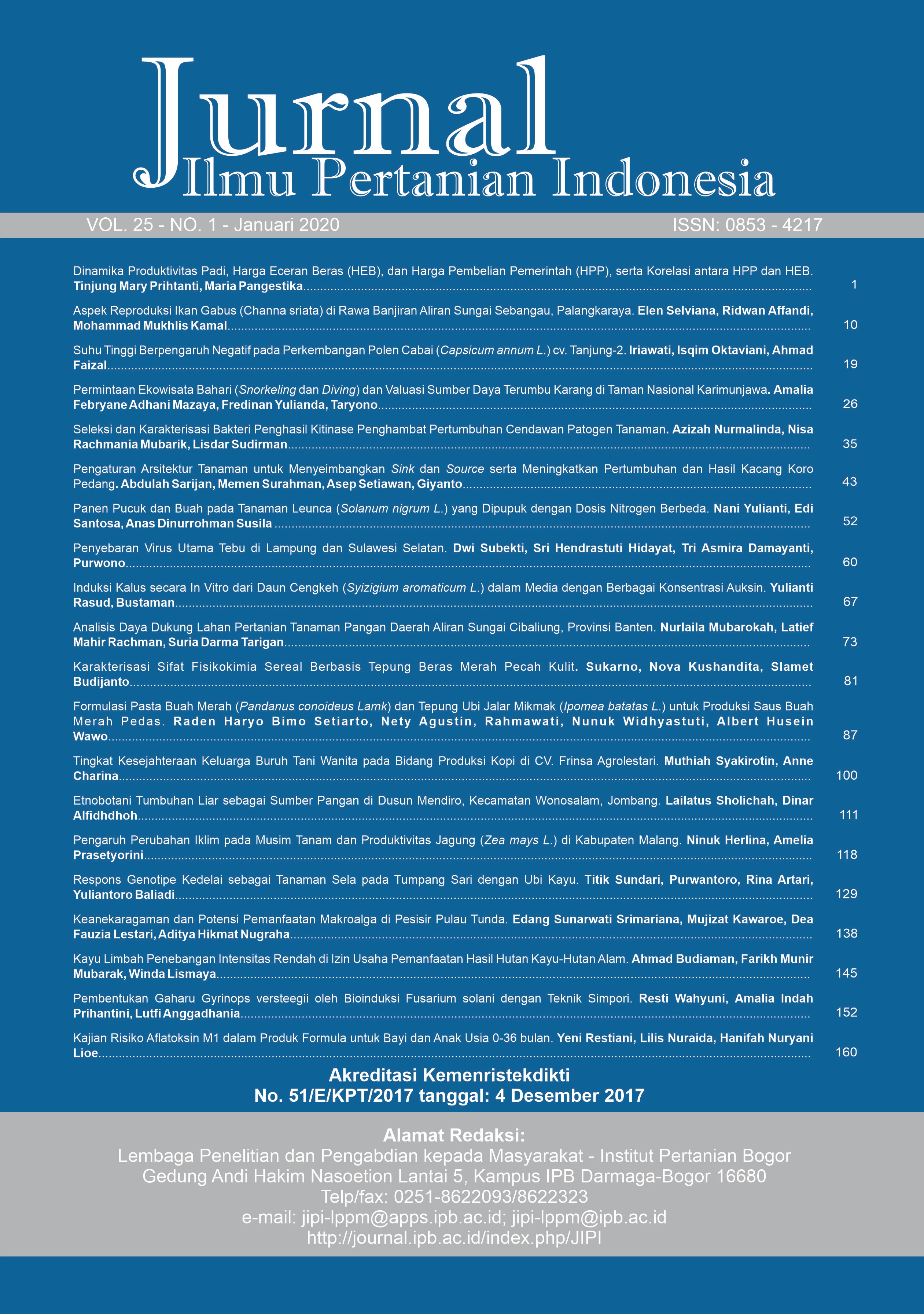Kajian Risiko Aflatoksin M1 dalam Produk Formula untuk Bayi dan Anak Usia 0-36 Bulan
Abstract
Aflatoxin M1 (AFM1) is a carcinogenic compound found in milk-based products including infant and young children formula. The aim of this study was to determine the risk characterization of infants and young children to AFM1 through the consumption of formula products. For this purpose, the Estimated Daily Intake (EDI) for infants and young children was calculated by multiplying AFM1 concentration in 44 infant formulas, 53 advanced infant formulas, and 16 growing up formulas with consumption data. The concentration of AFM1 in these formula products were retrieved from food registration in Indonesian FDA from January 2015-June 2018. The average concentration of AFM1 in infant formula, advanced infant formulas, and growing up formula (lower bound-upper bound) were 0.0226-0.0335; 0.0418-0.0510; and 0.0038-0.0123 ng/g, respectively. The average EDI of AFM1 for infants and young children aged 0-6 months, 6-12 months, and 1-3 years based on individual consumption were 0.260-0.386, 0.282-0.343, 0.029-0.092 ng/kg body weight (BW)/day. The average EDI of AFM1 for infants and young children aged 0-6 months, 6-12 months, and 1-3 years based on the recommended consumption by food producer (lower bound-upper bound) were 0.403-0.598; 0.663-0.809; 0.031-0.098 ng/kgBW/day. The average hazard index (HI) values for infants aged 0-6 months and 6-12 months (lower bound-upper bound) were greater than 1 (one), i.e., 1.94-2.88 and 3.20-3.90, which indicates there is a health risk. However hazard index value for young children aged 1-3 years (lower bound-upper bound) were less than 1 (one), i.e., 0.15-0.47, which indicates a lower health risk.
Keywords: advanced infant formula, aflatoxin M1, growing up formula, hazard index, infant formula
Downloads
References
[EC] European Commission. 2010. Commission Regulation (EC) No. 165/2010 of 26 February of 2010 Amending Regulation (EC) No. 1881/2006.
Gizachew D, Szonyi B, Tegegne A, Hanson J, Grace D. 2016. Aflatoxin contamination of milk and dairy feeds in the Greater Addis Ababa milk shed, Ethiopia. Food Control. 59: 773-779. https://doi.org/10.1016/j.foodcont.2015.06.060
Gong YY, Hounsa A, Egal S, Turner PC, Sutcliffe AE, Hall AJ, Cardwell K, Wild CP. 2004. Postweaning exposure to Aflatoxin results in impaired child growth: A longitudinal study in Benin, West Africa. Environmental Health Perspectives. 112 (13): 1334-1338. https://doi.org/10.1289/ehp.6954
Ishikawa AT, Takabayashi-Yamashita CR, Ono EYS, Bagatin AK, Rigobello FF, Kawamura O, Hirooka EY, Itano EN. 2016. Exposure assessment of Infants to Aflatoxin M1 through consumption of breast milk and infant powdered milk in Brazil. Toxins. 8: 246. https://doi.org/10.3390/toxins8090246
Kang Y, Song JE, Suh J, Park SK, Kim M. 2013. Analysis and risk assessment of aflatoxin M1 in infant formula. Korean Journal Food Science Technology. 45(2): 235-240. https://doi.org/10.9721/KJFST.2013.45.2.235
Kanungo L, Bhand S. 2013. A survey of Aflatoxin M1 in some commercial milk samples and infant formula milk samples in Goa, India. Food Agriculture Immunology. 1: 1-1. https://doi.org/10.1080/09540105.2013.837031
[Kemenkes] Kementerian Kesehatan RI. 2014. Buku studi diet total: Survei Konsumsi Makanan Individu Indonesia 2014. Jakarta (ID): Lembaga Penerbitan Litbangkes.
Kuiper-Goodman T. 1990. Uncertainties in the risk assessment of three mycotoxins: Aflatoxin, ochratoxin, and zearalenone. Canadian Journal Physiology Pharmacology. 68(7): 1017-1024. https://doi.org/10.1139/y90-155
Meucci V, Razzuoli E, Soldani G, Massart F. 2010. Mycotoxin detection in infant formula milks in Italy. Food Additives and Contaminants: Part A, 27(1): 64-71. https://doi.org/10.1080/02652030903207201
Milicevic D, Spiric D, Jankovic S, Radicevic T, Petrovic Z, Stefanovic S. 2017. Aflatoxin M1 in Processed Milk: Occurence and Seasonal Variation With an Emphasis on Risk Assessment of Human Exposure in Serbia. IOP Conference l/l0ce Series: Earth and Environmental Science 85(017): 012040. https://doi.org/10.1088/1755-1315/85/1/012040
Magoha H, Kimanya M, Meulenaer BD, Roberfroid D, Lachat C, Kolsteren P. 2014. Association between aflatoxin M-1 exposure through breast milk and growth impairment in infants from Northern Tanzania. World Mycotoxin Journal. 7(3): 277-284. https://doi.org/10.3920/WMJ2014.1705
Roussi V, Govaris A, Varagouli A, Botsoglou NA. 2002. Occurrence of aflatoxin M1 in raw and market milk commercialized in Greece. Food Additives and Contaminants: Part A. 19(9): 863-868. https://doi.org/10.1080/02652030210146864
Skrbic B, Zivancev J, Antic I, Godula M. 2014. Levels of Aflatoxin M1 in Different Types of Milk Collected in Serbia: Assessment of Human and animal Exposure. Food Control. 40: 113-119. https://doi.org/10.1016/j.foodcont.2013.11.039
Tsakiris IN, Tzatzarakis MN, Alegakis AK, Vlachou MI, Renieri EA, Tsatsakis AM. 2013. Risk assessment scenarios of children’s exposure to aflatoxin M1 residues in different milk types fromthe Greek market. Food Chemical Toxicology. 56: 261-265. https://doi.org/10.1016/j.fct.2013.02.024
[WHO] World Health Organization 2017. Evaluation of certain contaminant in food. Eighty-third report of joint FAO/WHO Consultation in Food Additives.Rome FAO dan WHO.
This journal is published under the terms of the Creative Commons Attribution-NonCommercial 4.0 International License. Authors who publish with this journal agree to the following terms: Authors retain copyright and grant the journal right of first publication with the work simultaneously licensed under a Creative Commons Attribution-NonCommercial 4.0 International License. Attribution — You must give appropriate credit, provide a link to the license, and indicate if changes were made. You may do so in any reasonable manner, but not in any way that suggests the licensor endorses you or your use. NonCommercial — You may not use the material for commercial purposes.






















